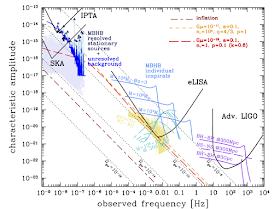I mean us theoretical particle physicists. With this constraint, the short answer is not much. Of course, every human being must experience shock and awe when picturing the phenomenon observed by LIGO. Two black holes spiraling into each other and merging in a cataclysmic event which releases energy equivalent to 3 solar masses within a fraction of a second.... Besides, one can only admire the ingenuity that allows us to detect here on Earth a disturbance of the gravitational field created in a galaxy 1.3 billion light years away. In more practical terms, the LIGO announcement starts the era of gravitational wave astronomy and thus opens a new window on the universe. In particular, LIGO's discovery is a first ever observation of a black hole binary, and we should soon learn more about the ubiquity of astrophysical systems containing one or more black holes. Furthermore, it is possible that we will discover completely new objects whose existence we don't even suspect. Still, all of the above is what I fondly call dirty astrophysics on this blog, and it does not touch upon any fundamental issues. What are the prospects for learning something new about those?
In the long run, I think we can be cautiously optimistic. While we haven't learned anything unexpected from today's LIGO announcement, progress in gravitational wave astronomy should eventually teach us something about fundamental physics. First of all, advances in astronomy, inevitably brought by this new experimental technique, will allow us to better measure the basic parameters of the universe. This in turn will provide us information about aspects of fundamental physics that can affect the entire universe, such as e.g. the dark energy. Moreover, by observing phenomena occurring in strong gravitational fields and of which signals propagate over large distances, we can place constraints on modifications of Einstein gravity such as the graviton mass (on the downside, often there is no consistent alternative theory that can be constrained).
Closer to our hearts, one potential source of gravitational waves is a strongly first-order phase transition. Such an event may have occurred as the early universe was cooling down. Below a certain critical temperature a symmetric phase of the high-energy theory may no longer be energetically preferred, and the universe enters a new phase where the symmetry is broken. If the transition is violent (strongly first-order in the physics jargon), bubbles of the new phase emerge, expand, and collide, until they fill the entire visible universe. Such a dramatic event produces gravitational waves with the amplitude that may be observable by future experiments. Two examples of phase transitions we suspect to have occurred are the QCD phase transition around T=100 MeV, and the electroweak phase transition around T=100 GeV. The Standard Model predicts that neither is first order, however new physics beyond the Standard Model may change that conclusion. Many examples of required new physics have been proposed to modify the electroweak phase transition, for example models with additional Higgs scalars, or with warped extra dimensions. Moreover, the phase transition could be related to symmetry breaking in a hidden sector that is very weakly or not at all coupled (except via gravity) to ordinary matter. Therefore, by observing or putting limits on phase transitions in the early universe we will obtain complementary information about the fundamental theory at high energies.
Gravitational waves from phase transitions are typically predicted to peak at frequencies much smaller than the ones probed by LIGO (35 to 250 Hz). The next generation of gravitational telescopes will be more equipped to detect such a signal thanks to a much larger arm-length (see figure borrowed from here). This concerns especially the eLISA space interferometer which will probe millihertz frequencies. Even smaller frequencies can be probed by pulsar timing arrays which search for signals of gravitational waves using stable pulsars for an antenna. The worry is that the interesting signal may be obscured by astrophysical backgrounds, such as (oh horror) gravitational wave emission from white dwarf binaries. Another interesting beacon for future experiments is to detect gravitational waves from inflation (almost discovered 2 years ago via another method by the BICEP collaboration). However, given the constraints from the CMB observations, the inflation signal may well be too weak even for the future giant space interferometers like DECIGO or BBO.
To summarize, the importance of the LIGO discovery for the field of particle physics is mostly the boost it gives to further experimental efforts in this direction. Hopefully, the eLISA project will now take off, and other ideas will emerge. Once gravitational wave experiments become sensitive to sub-Hertz frequencies, they will start probing the parameter space of interesting theories beyond the Standard Model.
Thanks YouTube! It's the first time I see a webcast of a highly anticipated event running smoothly in spite of 100000 viewers. This can be contrasted with Physical Review Letters who struggled to make one damn pdf file accessible ;)


